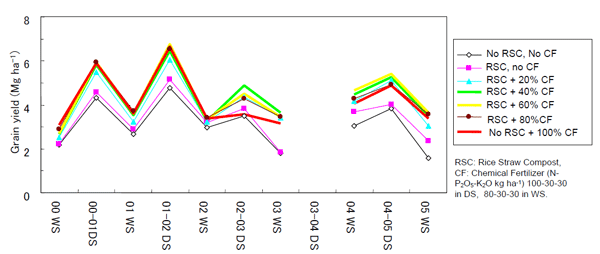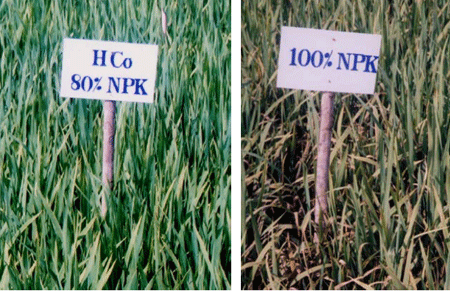Effects of rice straw compost on rice cultivation on alluvial soil area in Mekong Delta, Vietnam
Description
Few farmers in the Mekong Delta, Vietnam use organic matter for their rice cultivation. This is quite different from farmers in Vietnam’s Red River Delta. Soil in the alluvial soil area in the Mekong Delta is fertile because nutrients have been supplied by floodwaters that arrive annually. However, it appears that exhaustion of soil fertility has been accelerated by intensive agriculture and the supply of nutrients by floodwaters has decreased due to dyke construction.
We conducted field experiments in an alluvial soil area in the Mekong Delta to elucidate the effects of rice straw compost. Rice was cultivated over 10 seasons with replicated management. Rice straw compost (6 Mg ha–1) and different doses of chemical fertilizer were applied to compare with general fertilizer application without application of organic matter.
The results showed that it is possible to decrease chemical fertilizer (N, P and K) input by 60% without decreasing rice yield by applying rice straw compost (Fig. 1). Although the difference was not significantly different except for the 6th season, rice yields cultivated using chemical fertilizer alone were constantly lower than rice yields where rice straw compost and decreased amounts (up to 60%) of chemical fertilizer were applied.
Rice yields with general fertilizer application were significantly lower after outbreak of disease (in the 6th season). Rice cultivated using general fertilizer application was more severely damaged by rice blast than rice cultivated with rice straw compost and smaller amounts of chemical fertilizer (Fig. 2).
Soil organic matter, total-N and available-N did not show a clear difference among treatments after the 10th season. Originally, these concentrations were high in the field (Total-C: 31.7 gC kg–1, Total-N 3.0 gN kg–1, Available-N: 145 kgN ha–1 in the 0-10 cm soil layer). Ten seasons were not enough to cause significant differences in these parameters.
The results showed that general fertilizer application should be improved to increase fertilizer efficiency and mitigate pest damage.
Figure, table
-
Fig. 1. Grain yield over 10 seasons.
WS: Wet Season, DS: Dry Season -
Fig. 2. Rice heavily damaged by blast disease after general fertilizer application.
Right: General fertilizer application (100-30-30 N-P2O5-K2O kg ha-1).
Left: Rice straw compost (6 Mg ha-1) and (80-24-24 N-P2O5-K2O kg ha-1).
- Affiliation
-
Japan International Research Center for Agricultural Sciences Crop Production and Environment Division
- Classification
-
Technical A
- Term of research
-
FY2005(FY1999~2005)
- Responsible researcher
-
WATANABE Takeshi ( Crop Production and Environment Division )
Luu Hong Man ( Cuulong Delta Rice Research Institute )
VIEN Minh ( Can Tho University )
- ほか
- Publication, etc.
-
Watanabe, T. et al. (2005) Abstracts of the annual meeting, Japanese Society of Soil Science and Plant Nutrition, 124
L. H. Man, V. T. Khang and Watanabe T. (2003): Improvement of soil fertility by rice straw manure. Omon Rice, 74-82.
- Japanese PDF
-
2005_seikajouhou_A4_ja_Part6.pdf482.26 KB


